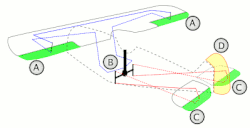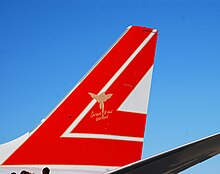Rudder
The rudder is used to turn an aircraft around its vertical axis , also known as yawing or turning .
There is a surface located on the vertical stabilizer is the aircraft and can be moved about a vertical axis, in the result, the plane rotates about the vertical axis. The pilot moves the rudder with two pedals. When landing, the pilot can use the rudder to turn the aircraft in the direction of the runway if it is deflected by the crosswind. When taxiing on the airfield , changes of direction are made with the rudder pedals, which, depending on the aircraft model, also control the nose or tail wheel .
use
The rudder is mainly used to neutralize a negative turning moment that is caused by the asymmetrical air resistance distribution when the aileron is deflected. The rudder is deflected together with the aileron in the same direction, simultaneously and proportionally.
In two-engine or multi-engine aircraft, if the engine fails, a strong torque arises around the vertical axis, which would result in a rapid turning movement of the aircraft. In order to still be able to fly straight ahead, the rudder torque has to be compensated for. This determines the necessary size of the rudder. The rudder is oversized for control movements in normal operation, so very small deflections are sufficient to control the aircraft.
In particular in jet-powered commercial aircraft that reach high flight speeds when cruising, the rudder must not be deflected too much at high speeds because it is not designed for the very high aerodynamic forces that then occur.
Some rudders have a trim tab for trimming .
Positive roll moment
Just as the aileron produces the negative turning moment as a secondary effect, the rudder also has a secondary effect. As soon as the rudder is deflected to the right, for example (the pilot presses the right rudder pedal forwards), a rotation about the vertical axis of the aircraft takes place because the tail drifts to the left. Thus (in this example) the left wing has a higher speed than the right during the turning movement, which creates a lift asymmetry along the wing and the aircraft rolls to the right. Because the resulting secondary rotation is nominally in the same direction as the initiating one, the roll moment, in contrast to the turning moment, is called positive.
See also
literature
- Ernst Götsch: Aircraft technology. Motorbuchverlag, Stuttgart 2003, ISBN 3-613-02006-8 .



